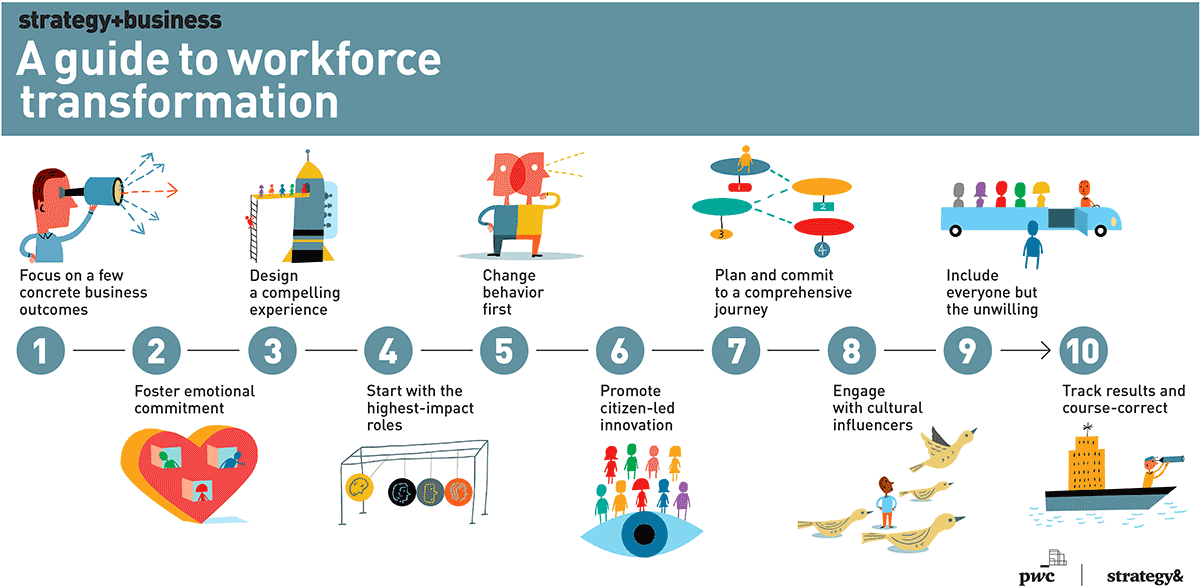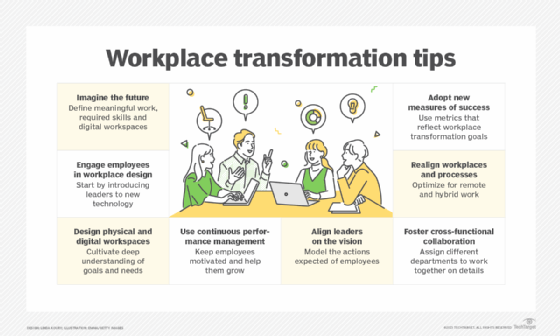Het geheime recept: ontdek de transformatieve stappen om de cultuur van uw werkplek te transformeren voor ongeëvenaard succes.

Inhoudsopgave
- Beoordeel de huidige werkplekcultuur
- Kernwaarden definiëren en communiceren
- Bevorder duidelijke en open communicatie
- Stimuleer samenwerking en teamwerk
- Investeer in professionele ontwikkeling
- Erken en waardeer de bijdragen van werknemers
- Bevorder de balans tussen werk en privéleven
- Omarm diversiteit en inclusie
- Leid door het goede voorbeeld
- Monitoren en aanpassen
- Conclusie
De cultuur op de werkplek is cruciaal voor het succes en het algehele welzijn van elke organisatie. positieve werkcultuur bevordert de betrokkenheid van werknemers, verbetert de productiviteit en verbetert de samenwerking. Aan de andere kant kan een negatieve of toxische werkplekcultuur leiden tot een hoog personeelsverloop, verminderde werktevredenheid en de groei van de organisatie belemmeren. Deze uitgebreide gids schetst praktische stappen om de werkplekcultuur te verbeteren, en helpt u een omgeving te creëren die positiviteit, productiviteit en werknemerstevredenheid bevordert.
Beoordeel de huidige werkplekcultuur
Voordat u begint aan de reis om de werkplekcultuur te verbeteren, is het essentieel om de bestaande cultuur te beoordelen, zowel de sterke punten als de gebieden die verbetering behoeven. Deze evaluatie helpt u het startpunt te identificeren en een gericht plan te ontwikkelen voor impactvolle veranderingen.
Begin met het uitvoeren van een enquête of anonieme feedbacksessies om inzichten van uw werknemers te verzamelen. Deze feedback kan waardevolle inzichten bieden in de huidige werkomgeving, tevredenheidsniveaus van werknemers en aandachtspunten. Analyseer de antwoorden om gemeenschappelijke thema's of patronen te identificeren die gebieden voor verbetering markeren.
Evalueer daarnaast bestaande beleidslijnen en praktijken binnen uw organisatie. Zijn ze afgestemd op het bevorderen van een positieve werkplekcultuur? Ondersteunen ze open communicatie en samenwerking? Identificeer discrepanties en gebieden waar beleid kan worden aangepast of verbeterd om aan te sluiten bij de gewenste culturele waarden.
Kernwaarden definiëren en communiceren
Een sterke werkplekcultuur is gebouwd op een fundament van goed gedefinieerde kernwaarden die alle werknemers delen. Deze waarden creëren gedeelde verwachtingen en sturen besluitvormingsprocessen in de hele organisatie.
Begin met het definiëren van de kernwaarden en missieverklaring van uw bedrijf. Denk na over welke principes essentieel zijn voor het succes van uw organisatie en het type cultuur dat u wilt bevorderen. Deze kunnen zijn: teamwerk, integriteit, continu leren, of klantgerichtheid. Communiceer deze waarden, zodra ze zijn gedefinieerd, duidelijk naar alle werknemers en belanghebbenden.
Zorg ervoor dat uw kernwaarden niet alleen woorden op een poster zijn, maar een integraal onderdeel van de dagelijkse gang van zaken. Moedig leiders en werknemers aan om deze waarden op te nemen in hun besluitvormingsprocessen. Om consistentie te creëren, stemt u organisatorische praktijken, programma's en beleid af op deze kernwaarden.
Bevorder duidelijke en open communicatie
Open en eerlijke communicatie is de ruggengraat van een positieve werkplekcultuur. Het bevordert transparantie, vertrouwen en betere samenwerking tussen werknemers. Het aanmoedigen van regelmatige communicatiekanalen kan de werkplekcultuur aanzienlijk verbeteren.
Richt meerdere communicatiekanalen in, zoals teamvergaderingen, suggestieboxen of digitale platforms, om werknemers aan te moedigen hun ideeën, zorgen of suggesties vrijelijk te uiten. Dit geeft iedereen de mogelijkheid om een stem te hebben en bevordert een gevoel van inclusiviteit.
Bevorder transparantie door werknemers regelmatig op de hoogte te houden van belangrijke bedrijfszaken. Het delen van informatie over nieuwe projecten, doelen of veranderingen kan vertrouwen kweken en ervoor zorgen dat werknemers zich betrokken voelen bij de voortgang van de organisatie. Openlijk communiceren over successen, uitdagingen en verbeterpunten creëert ook een cultuur van gedeelde verantwoordelijkheid.
Stimuleer samenwerking en teamwerk
Samenwerking en teamwerk zijn essentiële onderdelen van een positieve werkplekcultuur. Werknemers die samenwerken aan gemeenschappelijke doelen, verhogen de productiviteit en zorgen voor een gevoel van verbondenheid.
Creëer cross-functionele teams en moedig samenwerking aan tussen afdelingen en hiërarchische niveaus. Dit verbetert de vaardigheden van werknemers en bevordert een gevoel van eenheid en een gedeeld doel binnen de organisatie. Bevorder effectief teamwork door middel van teambuildingactiviteiten en -oefeningen, waardoor werknemers kunnen samenwerken en relaties kunnen ontwikkelen buiten hun reguliere werktaken.
Erken en vier collectieve prestaties in plaats van alleen te focussen op individueel succes. Erken en beloon teams voor hun gezamenlijke inspanningen, waarbij het belang van samenwerken aan gedeelde doelen wordt benadrukt.
Investeer in professionele ontwikkeling
Het bieden van mogelijkheden voor professionele ontwikkeling is een effectieve manier om de werkcultuur te verbeteren. Wanneer werknemers het gevoel hebben dat hun groei en carrièreontwikkeling worden ondersteund, bevordert dit betrokkenheid, werktevredenheiden loyaliteit.

Bied trainingsprogramma's, workshops of toegang tot bronnen die de vaardigheden, kennis en competenties van werknemers verbeteren. Dit verbetert hun capaciteiten en toont een investering in hun professionele groei.
Bevorder een cultuur van mentoring en coaching, moedig senior medewerkers aan om hun expertise en ervaringen te delen met hun collega's. Voer regelmatige check-ins in om individuele ontwikkelingsdoelen en voortgang te bespreken.
Erken en waardeer de bijdragen van werknemers
Erkenning en waardering zijn krachtige motivators die bijdragen aan een positieve werkcultuur. Het erkennen van de inspanningen en prestaties van werknemers helpt een ondersteunende en inclusieve werkomgeving te creëren.
Implementeer een erkenningsprogramma dat uitzonderlijke prestaties, innovatieve ideeën en boven-en-buiten erkent en beloont. Dit kan worden gedaan door middel van prijzen, publieke erkenning of financiële prikkels.
Geef regelmatig constructieve feedback, waarbij u zich richt op verbeterpunten en sterke punten en prestaties benadrukt. Vier professionele en persoonlijke mijlpalen om een gevoel van gemeenschap en steun onder werknemers te bevorderen.
Bevorder de balans tussen werk en privéleven
Een gezonde balans tussen werk en privé is cruciaal voor het welzijn, de tevredenheid en de productiviteit van werknemers. Het aanmoedigen van een flexibele en ondersteunende werkomgeving is essentieel voor het verbeteren van de werkplekcultuur.

Bied flexibele werkschema's aan waar mogelijk en bied mogelijkheden voor werken op afstand, zodat werknemers hun verplichtingen kunnen afstemmen op hun professionele verantwoordelijkheden. Het creëren van een ondersteunende omgeving waarin persoonlijke en gezinsbehoeften worden gerespecteerd, helpt de loyaliteit en betrokkenheid van werknemers te bevorderen.
Implementeer wellnessprogramma's of initiatieven die fysiek en mentaal welzijn bevorderen, zoals mindfulnessworkshops of fitnessuitdagingen. Moedig werknemers aan om pauzes, vakanties en offline tijd te nemen om burn-out te voorkomen en een gezonde balans tussen werk en privé te behouden.
Omarm diversiteit en inclusie
Een diverse en inclusieve werkplekcultuur draagt bij aan innovatie, creativiteit en betere besluitvorming. Diversiteit omarmen gaat verder dan het aannemen van een divers personeelsbestand; het bevordert een inclusieve omgeving waarin alle perspectieven gewaardeerd worden.
Neem inclusieve wervings- en aannamepraktijken aan die actief op zoek gaan naar kandidaten met diverse achtergronden. Zorg ervoor dat uw werkplekbeleid en -procedures onpartijdig zijn en gelijke kansen voor werknemers creëren.
Bied werknemers en leiders training in diversiteitsbewustzijn en -gevoeligheid, creëer bewustzijn en begrip voor verschillende culturen, achtergronden en perspectieven. Moedig werknemers aan om hun ervaringen en unieke standpunten te delen, bevorder een inclusieve dialoog en begrip.
Leid door het goede voorbeeld
Leiderschap speelt een fundamentele rol bij het vormgeven van de werkplekcultuur. Leiders moeten het goede voorbeeld geven en de gewenste culturele waarden en gedragingen van de organisatie bevorderen.
Benadruk het belang van het naleven van de kernwaarden en het vertonen van gedrag dat aansluit bij de bedrijfscultuur. Leiders moeten open communicatie, samenwerking en respect modelleren en werknemers inspireren om hetzelfde te doen.
Implementeer opendeurbeleid, waardoor leiders toegankelijk zijn voor werknemers op alle niveaus. Moedig leiders aan om actief naar werknemers te luisteren, hun meningen te waarderen en hun zorgen snel aan te pakken.
Monitoren en aanpassen
Het verbeteren van de werkplekcultuur is een doorlopend proces dat continue monitoring en aanpassing vereist. Beoordeel regelmatig de effectiviteit van de geïmplementeerde initiatieven en verzamel voortdurend feedback van werknemers.
Beoordeel de voortgang ten opzichte van vooraf gedefinieerde doelen en benchmarks. Analyseer feedback van werknemers, zowel kwalitatief als kwantitatief, om gebieden te identificeren die verbetering of extra ondersteuning nodig hebben. Overweeg om periodieke cultuuraudits of betrokkenheidsenquêtes uit te voeren om de algehele voortgang van uw transformatietraject naar werkplekcultuur te meten.
Pas strategieën en beleid aan op basis van feedback en veranderende behoeften. Flexibiliteit en de bereidheid om zich aan te passen zijn essentieel voor het creëren van een werkplekcultuur die evolueert met de organisatie en haar werknemers.
Conclusie
Het transformeren van de werkplekcultuur is een uitdagende maar lonende onderneming. Door de stappen in deze gids te volgen, kunt u de werkplekcultuur verbeteren en een positieve en inclusieve omgeving bevorderen. Vergeet niet dat het creëren van een positieve werkplekcultuur een voortdurende inzet is die voortdurende inspanning, ondersteuning en versterking van zowel leiders als werknemers vereist. Een cultuur omarmen die open communicatie bevordertSamenwerking, diversiteit en waardering leiden tot tevredenheid onder werknemers, verbeterde productiviteit en organisatorisch succes.
